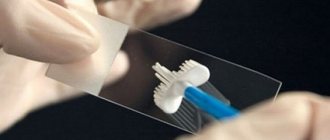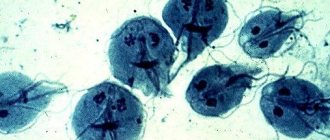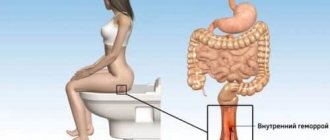Infection process
Every person suffering from enterobiasis is dangerous to others. After all, he is a potential carrier of parasites. This happens when pinworms multiply. At this moment, their life cycle takes place not only inside the intestine, but also outside:
- Sexually mature individuals mate.
- Fertilized females attach to the intestinal walls and begin to parasitize.
- After the eggs mature, the worm crawls out of the anus. This occurs in the evening and at night, when the human sphincter is relaxed.
- At one time, the parasite lays from five to seventeen thousand larvae on the skin of the genitals.
- After a few hours they become ripe.
Pinworm eggs end up on bedding, underwear, and skin. A person who accidentally touches the larvae transfers them to other objects with unwashed hands.
Due to poor sanitary hygiene, children become the most vulnerable age category to the disease. From the dirty hands of an infected child, parasite eggs end up on toys with which dozens of other children come into contact.
Once on the hands of healthy children, the larvae stick to their skin. After this, the baby just has to put his finger in his mouth or swallow any food, and future parasites enter the body.
Enterobiasis in children often takes on very intense forms. This happens due to self-infection repeated many times. The child scratches the itchy skin, the worm eggs get under the fingernails and ripen there after a few hours. After this, the child eats or puts it in his mouth with unwashed hands.
Diagnostic value of the analysis
Enterobiasis is a disease caused by pinworms . Their presence in the body can be determined using laboratory tests - scraping or testing feces for enterobiasis.
Scraping for enterobiasis allows you to determine whether there are pinworm eggs in the perianal folds. This research method is one of the types of helminthoovoscopy .
Enterobiasis is considered a disease of dirty hands. This disease most often occurs in childhood. Although the life cycle of one individual parasite is not very long, the disease can last for years. Pinworms parasitize the intestines and lay eggs in the skin folds around the anus. Since the pathology is accompanied by severe itching in the anal area, the child can scratch the skin and become re-infected through dirty hands.
Another type of test to detect pinworms is stool microscopy . The study allows you to determine whether there are helminth eggs in the patient’s stool.
Symptoms of enterobiasis
Signs of pinworm infection directly depend on the stage and intensity of the disease. Individual characteristics of a person play an important role.
After the initial entry of worm eggs into the body, the clinical incubation period begins. It lasts about two days, after which the acute phase of enterobiasis begins. It lasts about a week. At this time you may experience:
- discomfort and pain in the intestines;
- nausea;
- increasing the frequency of bowel movements up to four times a day (the stool remains normally formed).
After this, the unpleasant sensations (except for the increased frequency of going to the toilet) disappear. This is due to the characteristics of reproduction and life activity of female pinworms. After a few weeks, the disease enters the chronic stage. Symptoms of enterobiasis in children and adults vary.
Some infected people may not show signs of developing parasites. Others experience:
- itching in the anal area, occurring in the evenings and at night;
- pain in the abdominal area.
Such symptoms of enterobiasis last for several days and then disappear. After three to four weeks they appear again.
Parasites can enter the body many times. This happens through self-infection. Repeated invasions lead to the fact that the worms multiply very strongly, and the number of sexually mature individuals increases. With such intense and prolonged infections, the symptoms of enterobiasis intensify:
- itching in the anus begins to bother you not only at night, but also during the day;
- discomfort in the stomach becomes more intense;
- the stool becomes liquid;
- flatulence appears;
- often there is pain in the head;
- severe fatigue appears;
- in adults, memory and ability to work decrease;
- The child’s performance declines, attention becomes unstable, new information is perceived very slowly, and fainting and epileptic seizures may occur.
Given the highly contagious nature of the disease, if such signs appear, you should immediately visit a therapist.
Complications of enterobiasis
In severe forms of pinworm infection, not only symptoms characteristic of the disease are observed. The disease can provoke complications and serious secondary diseases.
Pathologies caused by enterobiasis include:
- allergic reactions;
- dysbacteriosis;
- vulvitis;
- vaginitis;
- endometritis;
- appendicitis;
- dermatitis;
- inflammation and eczema in the genital area;
- paraproctitis;
- rectal fistulas.
The female parasite can penetrate deep into the intestinal mucosa for almost the entire length of her body. In this case, a granuloma forms around the affected area. This kind of “cyst” limits the inflamed area from healthy tissue and gradually grows.
With a large accumulation of pinworms, the human body can suffer greatly from intoxication caused by the waste products of the worms. This is the reason for a significant decrease in immunity, leading to weak resistance of the body (especially children) to viral, bacterial and fungal diseases.
For pregnant women, such an anomaly is fraught with severe manifestations of toxicosis.
Tests for enterobiasis
Symptoms of pinworm infection only help to suspect the presence of the disease. For a doctor, familiarity with the patient’s clinical picture is not enough.
To confirm or refute the presence of a pathogen, it is necessary to conduct laboratory diagnostics - collect material and examine it under a microscope.
There are several ways to get tested for enterobiasis. Any of them helps to identify the presence of parasites quite accurately.
Scraping for enterobiasis
A smear for the presence of pinworms will be reliable if you do not wash your genitals before the test. Examination for enterobiasis using a scraping method is done as follows:
- the patient takes off his underwear and lies on his side;
- the doctor spreads his buttocks;
- The perianal folds are wiped with a swab soaked in glycerin.
The taken material is sent to the laboratory, where the necessary studies are carried out.
Graham (sticky tape) method
There is another way to identify pinworms in children and adults. Before performing it, you should also not wash your genitals. Its essence is as follows:
- the doctor spreads the patient’s buttocks;
- At the same time, the specialist applies a piece of adhesive tape to the perianal folds and anus for a few seconds.
After the procedure is completed, the material is glued to a glass slide and sent for examination.
Stool analysis
You can determine not only the presence of pinworms, but also identify another type of worms by examining the feces themselves. To do this, feces are collected into a clean container from several areas. There should be no urine impurities.
Such an analysis for eggworm and enterobiasis will be reliable if no more than five hours have passed since the bowel movement.
Blood analysis
Laboratory hematological tests for enterobiasis are not essential for diagnosing the disease.
Blood tests can only help determine the phase of development of pinworms. Against the background of moderate leukocytosis, an infected person experiences a change in the number of eosinophils, which:
- increase in the early phase;
- reach their maximum value (23%) on the sixteenth day;
- decrease to 4–5% by the end of the next infection cycle.
Blood tests are performed quite rarely, since the indicators vary greatly during different periods of invasion.
How to properly prepare for analysis and collect material
It is advisable to collect the material in the morning before defecation. There is no need to toilet the anogenital area. They take the material themselves at home or directly at a medical institution (clinic, laboratory, hospital, etc.).
A cotton swab, glass spatula, or adhesive tape can be used to collect the material. If collection is carried out independently, it is necessary to prepare a sterile container in advance (purchased at a pharmacy or laboratory). A cotton swab is moistened with warm boiled water, after which it is passed around the anus several times. There is no need to wet the glass spatula or tape with water. The material is placed in a container and transported to the laboratory as quickly as possible, preferably no later than two hours after collection.
In different laboratories, the conditions for preparing and submitting material for analysis for enterobiasis may differ.
If enterobiasis is diagnosed, as well as for the purpose of its prevention, it is recommended to include pomegranates, strawberries, carrots, garlic, walnuts, and pumpkin seeds in the diet.
Treatment of enterobiasis
With laboratory confirmation of the presence of pinworms, the doctor prescribes the necessary drug therapy. The most commonly used anthelmintic drugs are:
- Piperazine;
- Vermox;
- Mebendazole;
- Pirantel.
The medicine should be taken not only by the infected person, but also by his family members.
Treatment of enterobiasis in children involves a parallel examination of the entire team (class at school, group in kindergarten). If tests confirm the presence of parasites in more than fifteen percent of the examined population, then drug therapy is carried out in all children in a row. If a smaller number of children are infected, then only those who are confirmed to have pinworms are treated.
Ten days after taking anthelmintic drugs, patients are tested. If the result is negative, then a control laboratory examination is prescribed. It is carried out another ten days after the first. If the result is positive, treatment continues.
Decoding the results
A conclusion about the examination of the scraping is issued a day later. It can be positive or negative. If the result is positive, pinworms are found in the intestines and, depending on the severity of the parasite infestation, there are three degrees of pinworm infection:
- Weak. It is indicated when single helminth eggs are detected and is designated “+” in the certificate.
- Average. When several dozen pinworm eggs are detected. The certificate is marked with “++”.
- High. If a large number of worm larvae and eggs are detected, Fr.
In this situation, it is necessary to check for the presence of helminths in surrounding people and close relatives who are in contact with an infected patient. This is especially important when the child attends kindergarten or school.
If the result is negative, this indicates the absence of helminths in the intestines or that the collection of material was done in violation of the procedure. When collecting, a large number of factors should be taken into account, including the fact that the female pinworm has not yet laid eggs on the skin.
Children are recommended to be tested at least 3 times at weekly intervals. In this case, the reliability of the research is about 90%. Taking tests once gives results with 50% confidence. If there are no symptoms of infection, then a negative assessment is correct.
The test may show a negative result, but if symptoms of infection are present, the attending physician will usually recommend taking scrapings for enterobiasis several more times, after which he will prescribe treatment or preventive measures. However, some parents, in order to avoid having to undergo tests several times, on their own initiative give their children antihelminthic drugs for preventive purposes. This is strictly forbidden, since not all antihistamines can be used in the treatment of children due to strong toxic effects on the body. The decision to prescribe any drugs for the treatment or prevention of helminthic infestation should be made only by a qualified doctor.
Sometimes patients resort to the PCR diagnostic procedure. This method makes it possible to determine the presence of parasites with a 100% guarantee, but it is not popular due to its high cost.
Confirmation of enterobiasis allows you to begin treatment, which consists of following a special diet and using anthelmintic drugs. The course of therapy is prescribed by the doctor due to the characteristics of the body, the child’s age and body weight.
Analysis validity period
The test for enterobiasis remains effective for 3 days from the date of collection of the material. One should not forget about the expiration date, otherwise the analysis will be invalid and the patient will have to undergo the procedure again. If the scraping is overdue, it can mislead the laboratory researchers into giving an incorrect conclusion.
We should also not forget that the validity period of the scraping, or rather its results, should not exceed 10 days from the date of delivery. Otherwise, a certificate of absence of enterobiasis with a test date of more than ten days for presentation to kindergartens, schools or sports institutions will be invalid.
Prevention of enterobiasis
Getting rid of pinworms involves not only drug therapy, but also the use of certain sanitary and hygienic measures.
Prevention helps to avoid repeated self-infection and the spread of parasites to others.
Treatment of enterobiasis in adults and children must be accompanied by:
- washing hands with soap (before eating, after going outside and touching dirty objects)
- compliance with the rules of intimate hygiene;
- getting rid of the habit of biting your nails;
- wearing panties with rubberized legs;
- carrying out soda enemas of the intestines;
- daily change of underwear;
- performing constant wet cleaning of the home.
Preventive measures must be followed not only during the entire period of getting rid of the disease, but also for several weeks after that.










